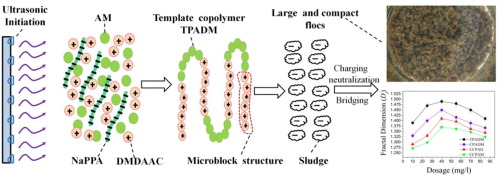Ultrasonics Sonochemistry ( IF 8.7 ) Pub Date : 2018-02-07 , DOI: 10.1016/j.ultsonch.2018.02.017 Li Feng , Shuang Liu , Huaili Zheng , Jianjun Liang , Yongjun Sun , Shixin Zhang , Xin Chen

|
In this study, the ultrasonic (US)-initiated template copolymerization was employed to synthesize a novel cationic polyacrylamide (CPAM) characterized by a microblock structure using dimethyldiallylammonium chloride (DMDAAC) and acrylamide (AM) as monomers, and sodium polyacrylate (NaPAA) as template. The polymers structure property was analyzed by Fourier transform infrared spectroscopy (FT-IR), 1H nuclear magnetic resonance spectroscopy (1H NMR) and thermogravimetric analysis (TGA). The results showed that a novel cationic microblock structure was successfully synthesized in the template copolymer of DMDAAC and AM (TPADM). Meanwhile, the analysis result of association constant (MK) provided powerful support for a I Zip-up (ZIP) template polymerization mechanism and the formation of the microblock structure. The factors affecting the polymerization were investigated, including ultrasonic power, ultrasonic time, monomer concentration, initiator concentration, mAM:mDMDAAC and nNaPAA:nDMDAAC. The sludge dewatering performance of the polymers was evaluated in terms of specific resistance to filtration (SRF), filter cake moisture content (FCMC), floc size (d50) and fractal dimension (Df). Flocculation mechanism was also analyzed and discussed. The sludge dewatering results revealed that the polymer with the novel microblock structure showed a more excellent flocculation performance than those with randomly distributed cationic units. A desirable flocculation performance with a SRF of 4.5×1012 m·kg-1, FCMC of 73.1%, d50 of 439.156 µm and Df of 1.490 were obtained at pH of 7.0, dosage of 40 mg·L-1 and the molecular weight of 5.0×106 Da. The cationic microblock extremely enhanced the polymer charge neutralization and bridging ability, thus obtaining the excellent sludge dewatering performance.
中文翻译:

使用超声(美国)引发的模板共聚合制备增强型阳离子聚丙烯酰胺(CPAM)及其在污泥脱水中的应用
在这项研究中,超声(US)引发的模板共聚被用于合成新型阳离子聚丙烯酰胺(CPAM),其特征在于使用二甲基二烯丙基氯化铵(DMDAAC)和丙烯酰胺(AM)作为单体,聚丙烯酸钠(NaPAA)作为微嵌段结构模板。通过傅立叶变换红外光谱(FT-IR),1 H核磁共振光谱(1 H NMR)和热重分析(TGA)分析聚合物的结构性质。结果表明,在DMDAAC和AM的模板共聚物(TPADM)中成功合成了新型的阳离子微嵌段结构。同时,关联常数的分析结果(M K)为I Zip-up(ZIP)模板聚合机制和微嵌段结构的形成提供了有力的支持。研究了影响聚合的因素,包括超声功率,超声时间,单体浓度,引发剂浓度,m AM:m DMDAAC和n NaPAA:n DMDAAC。聚合物的污泥脱水性能根据过滤的比抗力(SRF),滤饼含水量(FCMC),絮凝物尺寸(d 50)和分形维数(D f)进行评估)。絮凝机理也进行了分析和讨论。污泥的脱水结果表明,具有新型微嵌段结构的聚合物比具有随机分布的阳离子单元的聚合物表现出更优异的絮凝性能。具有4.5×10 SRF理想的絮凝性能12米千克· -1,73.1%,d FCMC 50的439.156 μ m和d ˚F物在pH值为7.0得到1.490,40毫克剂量·L -1和分子量为5.0×10 6 Da。阳离子微嵌段极大地增强了聚合物的电荷中和和桥接能力,从而获得了优异的污泥脱水性能。











































 京公网安备 11010802027423号
京公网安备 11010802027423号